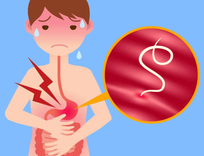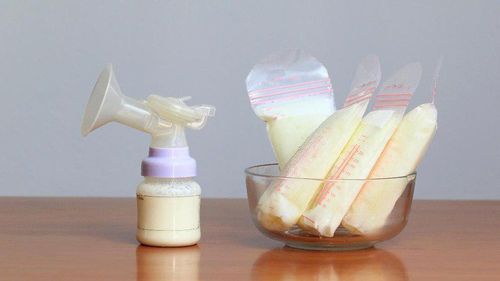The article is professionally consulted by Specialist Doctor II Lê Thanh Cẩm - Department of Pediatrics - Neonatology, Vinmec Da Nang International General Hospital. Dr. Cẩm has 15 years of experience in diagnosing and treating pediatric diseases and has worked at the Pediatrics Department of Da Nang Hospital and Da Nang Obstetrics and Pediatrics Center. Her expertise lies in diagnosing and treating pediatric diseases, pediatric resuscitation, and emergency care.
Milk aspiration into the nose is an extremely dangerous complication for newborns. It is quite common and can be fatal if not handled promptly. So, what factors easily cause milk aspiration in newborns?
1. Causes of Milk Aspiration in Newborns
Newborns may aspirate milk due to the following factors:
Bottle-feeding with the nipple far away, the baby's mouth not fully closed, or the bottle not tilted high enough. This results in the baby swallowing a lot of air while feeding, leading to bloating and vomiting after feeding.
The hole in the nipple is too large, causing milk to flow quickly and forcefully, which the baby cannot swallow in time.
Forcing the baby to drink too much, leading to regurgitation. Sometimes parents pinch the baby's nose to make them open their mouth and pour milk or porridge in, causing milk aspiration into the nose.
The baby has a habit of eating while sleeping: Many mothers let their babies lie down to bottle-feed, so the baby eats and sleeps simultaneously. During feeding, the baby may fall asleep, with the nipple still in the mouth but not swallowing. When breathing heavily, the baby accidentally inhales milk into the nose, leading to milk aspiration and difficulty breathing.
Laying the baby down immediately after feeding: Newborns often fall asleep right after feeding. Many mothers lay the baby down on their back, which is dangerous because the chance of milk aspiration into the nose is high, and the baby cannot turn their head to escape the suffocation.
Not monitoring the baby regularly after feeding (many cases of milk aspiration death occur without the parents knowing).
Babies 3-4 months old who start talking: The feeder talks to the baby during feeding, and the baby gets distracted, holding milk in the mouth without swallowing. When the baby smiles, milk enters the airway, causing milk aspiration into the nose.
When a baby aspirates milk, it enters the respiratory tract, causing suffocation, leading to death or leaving complications such as brain damage (hemorrhage, brain death), cardiac arrest, pneumonia (due to inhaling food, gut bacteria reaching the lungs).
Trắc nghiệm: các chỉ số cần chú ý về sự phát triển thể chất của trẻ
Chiều cao, cân nặng của bé ở từng giai đoạn nên là bao nhiêu là bình thường, bao nhiêu là bất thường? Cùng ThS.BS Ma Văn Thấm điểm lại xem bạn đã nắm được các chỉ số phát triển thể chất của bé chưa nhé!The following content is prepared under supervision of Thạc sĩ, Bác sĩ y khoa, Ma Văn Thấm , Nhi , Phòng khám Đa khoa Vinmec Dương Đông(Phú Quốc)
2. Handling Milk Aspiration into the Nose
Accurate handling of milk aspiration into the nose in newborns requires following these steps. Note that if the baby breathes normally after any step, the following steps are not necessary.
Step 1: Sit the Baby Up
When the baby shows signs of milk aspiration into the nose, the mother should perform basic first aid immediately.
Sit the baby up straight, allowing them to cough and expel the milk. If the baby is still coughing, it means the airway is only slightly blocked.
Wipe clean the milk from the mouth, nose, and other parts.
Step 2: Suction the Milk
If the baby has difficulty breathing and the skin turns blue, you need to suction the milk from the nose and mouth immediately. This is the first step of first aid while waiting for the ambulance.
Use your mouth to suction the milk quickly and forcefully, then stimulate the baby to breathe out by giving a gentle pinch.
Step 3: Turn the Baby Upside Down and Pat Gently
If the baby still has difficulty breathing and blue skin after the third step, turn the baby upside down.
Place the baby face down on your arm, and use your other hand to pat the back gently, five times. Turn the baby back to see if they have expelled the milk and are breathing normally.
Step 4: Press the Chest
If the baby still does not show signs of breathing by step 3, perform another first aid method.
Lay the baby on their back, one hand holding the head, and the other hand pressing lightly on the chest to help the baby breathe.
Step 5: Take the Baby to the Emergency Room
If the baby still cannot breathe, repeat steps 2, 3, and 4 while taking the baby to the emergency room.
3. Preventing Milk Aspiration in Newborns
After feeding, hold the baby upright for at least 15 minutes and pat the back gently to help burp.
Newborns often aspirate milk into the nose, but with proper care and feeding, this can be avoided.
Do not let the baby eat while sleeping. Moreover, do not play with the baby during feeding, as this can make the baby laugh and lead to milk aspiration.
Feed in a quiet place and avoid playing with the baby to prevent distraction.
Feed with the baby's head elevated (hold the baby or place them in a semi-reclined chair). Avoid laying the baby flat. If the baby has a stuffy nose, clear the mucus from the nose and mouth before feeding.
When bottle-feeding with a rubber nipple, tilt the bottle so that milk fills the neck to prevent the baby from swallowing air into the stomach. Choose a bottle with a nipple hole that is not too large to ensure milk flows gently, preventing milk aspiration into the nose.
When bottle-feeding, tilt the bottle at a 45-degree angle to fill the nipple hole with milk, reducing the chance of milk aspiration or vomiting after feeding.
For babies with upper respiratory tract infections, feed slowly (do not use a nipple with a too-large hole). Stop feeding if the baby cannot swallow in time.
After feeding, hold the baby upright for at least 15 minutes and pat the back gently to help burp.
Do not let the baby lie face down or with the face towards the wall. Regularly monitor the baby's sleep.
Avoid letting the baby sleep in environments that are too hot or too cold to prevent breathing rhythm disorders.
For babies with heart disease or severe pneumonia, consult a doctor for proper feeding methods. If you are unsure how to care for a premature baby or a baby with heart disease or severe pneumonia, see a pediatrician for detailed advice.
Please dial HOTLINE for more information or register for an appointment HERE. Download MyVinmec app to make appointments faster and to manage your bookings easily.

















